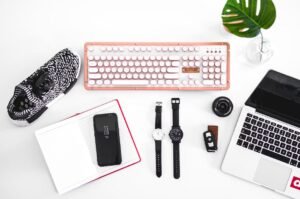Where to Apply Bronzer
Applying bronzer is a great way to add warmth and depth to your complexion, creating a sun-kissed glow all year round. Proper application technique is essential to achieve a natural and radiant look. Bronzer should be strategically placed on areas of the face that the sun would naturally hit, enhancing your features and giving you that desirable summertime glow. Here are some tips on where to apply bronzer for a flawless finish.
Key Takeaways:
- Strategically apply bronzer to areas of the face that the sun would naturally hit.
- Use a light hand when applying bronzer to avoid a heavy or muddy look.
- Blend well for a seamless and natural finish.
1. Cheeks
The most common and essential area to apply bronzer is on the cheeks. Start by lightly sweeping the bronzer along the cheekbones, blending upwards towards the temples for a natural and lifted effect. This helps to define your facial structure and adds warmth to the complexion.
2. Forehead and Hairline
Adding a touch of bronzer to the forehead and hairline can create a more balanced and sun-kissed look. Using a large, fluffy brush, dust a small amount of bronzer onto the upper forehead and along the hairline, blending it softly into the skin. This technique can give the illusion of a slightly sun-touched forehead.
3. Jawline and Neck
To create a seamless transition between the face and neck, lightly dust bronzer onto the lower jawline and blend it downwards towards the neck. This will help to frame the face and avoid any harsh lines. Remember to blend well for a natural look.
| Area | Application Technique |
|---|---|
| Cheeks | Lightly sweep along the cheekbones, blending upwards towards the temples. |
| Forehead and Hairline | Dust onto the upper forehead and along the hairline, blending softly. |
| Jawline and Neck | Dust onto the lower jawline, blending downwards towards the neck. |
4. Nose
To achieve a subtle sun-kissed look, lightly dust a small amount of bronzer along the sides of the nose. This will add warmth and dimension without looking too heavy. Remember to blend well to avoid any harsh lines or stripes.
5. Collarbones and Shoulders
If you want to extend your bronzed glow beyond the face, apply bronzer to your collarbones and shoulders. This technique is perfect for achieving a radiant look when wearing off-the-shoulder tops or dresses. Gently dust a small amount of bronzer onto these areas using a fluffy brush.
| Area | Application Technique |
|---|---|
| Nose | Lightly dust along the sides for a subtle sun-kissed look. |
| Collarbones and Shoulders | Dust onto these areas for a radiant look while wearing off-the-shoulder tops or dresses. |
By strategically applying bronzer to areas of the face that would naturally catch the sun, you can achieve a natural and radiant glow. Whether you are aiming to define your features or simply enhance your complexion, proper bronzer application can make a significant difference. Remember to use a light hand, blend well, and choose a bronzer shade that complements your skin tone.
References:
- https://www.cosmopolitan.com/style-beauty/beauty/how-to/g3013/the-right-way-to-apply-bronzer/
- https://www.byrdie.com/how-to-apply-bronzer-345171
- https://www.goodhousekeeping.com/beauty/makeup/a34073964/how-to-apply-bronzer/

Common Misconceptions
Misconception 1: Bronzer should only be applied to the cheeks
One common misconception about applying bronzer is that it should only be applied to the cheeks. However, this is not entirely true. While the cheeks are a popular area to apply bronzer for a warm and sun-kissed look, bronzer can also be applied to other areas of the face for a more even and natural-looking glow.
- Bronzer can also be applied to the temples and forehead to create a more balanced look.
- Applying bronzer along the jawline can help define and contour the face.
- Applying bronzer to the bridge of the nose can create a subtle sun-kissed effect.
Misconception 2: Bronzer should be applied all over the face
Another misconception is that bronzer should be applied all over the face for a tanned appearance. However, this can result in an unnatural and muddy look. Bronzer should be used strategically to enhance certain features and add warmth to the complexion.
- Focusing bronzer on the areas where the sun naturally hits the face, such as the forehead, cheeks, and nose, is more flattering and realistic.
- Using a light hand to apply bronzer can help avoid an overly bronzed appearance.
- Blending the bronzer well with a brush or makeup sponge is important to achieve a seamless and natural finish.
Misconception 3: Bronzer is only for fair-skinned individuals
Some people believe that bronzer is only meant for fair-skinned individuals because it adds color to their complexion. However, this is not true. Bronzer can be used by individuals of all skin tones to add warmth and dimension to the face.
- For fair skin, using a light and natural shade of bronzer can create a subtle and natural-looking glow.
- Medium and deep skin tones can opt for bronzers with richer tones to achieve a more pronounced effect.
- Choosing the right shade of bronzer that complements your skin tone is key to achieving a natural and flattering result.
Misconception 4: Bronzer is only used during the summer
Many people associate bronzer with summertime and believe that it is only necessary to use during the warmer months. However, bronzer can be used year-round to add warmth and depth to the complexion, regardless of the season.
- During the winter months, using a lighter hand with bronzer can still help achieve a healthy and radiant look.
- Applying bronzer in the fall and spring can provide a beautiful transition from the lighter makeup looks of spring to the richer tones of fall.
- Using bronzer sparingly in colder months can still add a touch of color and vitality to the face.
Misconception 5: Bronzer is only for women
One misconception about bronzer is that it is exclusively for women. However, bronzer can be used by anyone, regardless of gender, to enhance and sculpt the face for a more polished and defined look.
- Using a matte bronzer with cool undertones can create a subtle contour for men without looking too shimmery or feminine.
- Choosing a bronzer with a more natural finish can help men achieve a sun-kissed look without appearing heavily made-up.
- Applying bronzer to areas such as the cheekbones and jawline can help add definition and structure to the face for both men and women.

Understanding Bronzer Shades
Bronzers come in various shades, each suitable for different skin tones and desired effects. To help you choose the perfect bronzer shade for your complexion, refer to the table below:
| Skin Tone | Recommended Bronzer Shade |
|---|---|
| Fair/Light | Light Tan |
| Medium | Golden Brown |
| Olive | Warm Bronze |
| Deep | Rich Mahogany |
Diverse Application Techniques
Applying bronzer requires more than just swiping it on. Different application techniques can yield various results. Discover the most effective techniques in the table below:
| Technique | Description |
|---|---|
| The “3” Method | Sweep the bronzer along the temples, under the cheekbones, and jawline, creating a “3” shape on each side of the face. |
| Sun-Kissed Glow | Apply bronzer on the high points of the face that the sun naturally hits, such as the forehead, nose, cheeks, and chin. |
| Contouring | Use a matte bronzer to contour the hollows of the cheeks, the sides of the nose, and the jawline, enhancing facial structure. |
| All-over Bronze | Dust bronzer lightly all over the face for an overall sunkissed effect. |
Bronzer vs. Self-tanner
Many people confuse the purpose of bronzer and self-tanner. While both can enhance the appearance of the skin, they serve different purposes. Understand the key differences below:
| Bronzer | Self-tanner |
|---|---|
| Temporary | Long-lasting |
| Enhances complexion | Changes complexion |
| Washable | Stains skin |
| Instant results | Develops over time |
Bronzer Formulations Comparison
When shopping for bronzer, you’ll come across different formulations such as powders, creams, and liquids. Determine which formulation suits you best by examining the advantages of each below:
| Powder Bronzers | Cream Bronzers | Liquid Bronzers |
|---|---|---|
| Easy to blend | Buildable coverage | Sheer and lightweight |
| Long-lasting | Natural finish | Dewy look |
| Great for oily skin | Hydrating for dry skin | Can be mixed with foundation |
Selecting the Right Brush
The type of brush you use impacts how your bronzer appears on the skin. Consider the following options to achieve your desired bronzing effect:
| Brush Type | Uses |
|---|---|
| Dome brush | Perfect for all-over bronzing |
| Angled brush | Great for contouring and precise application |
| Kabuki brush | Provides a flawless finish |
| Fan brush | Ideal for a subtle application and highlighter |
Popular Bronzer Brands
There are countless bronzer brands on the market, each offering unique features and quality. Here are some of the most popular bronzer brands among makeup enthusiasts:
| Brand | Special Features |
|---|---|
| NARS | Wide range of shades and finishes |
| Physicians Formula | Hypoallergenic and fragrance-free options |
| Benefit Cosmetics | Includes bronzers with built-in highlighters |
Avoiding Common Bronzer Mistakes
Applying bronzer incorrectly can lead to an unnatural or muddy appearance. Steer clear of these common bronzer mistakes:
| Mistake | Prevention |
|---|---|
| Applying too much bronzer | Start with a small amount and build up gradually |
| Choosing the wrong shade | Test shades on your skin before purchasing |
| Using bronzer as a substitute for foundation | Apply bronzer after foundation for a natural look |
Benefits of Using Bronzer
Bronzer offers more than just a sun-kissed appearance. Some key benefits of using bronzer include:
| Benefit | Description |
|---|---|
| Enhanced facial structure | Contouring with bronzer can help define and sculpt the face. |
| A healthy glow | Bronzer can mimic a vacation tan, making you look radiant and refreshed. |
| Minimizes the appearance of imperfections | Strategic bronzer application can minimize the appearance of blemishes and uneven skin tone. |
Bronzer not only adds warmth and dimension to your complexion but also enhances your facial features and overall appearance. Whether you’re a makeup novice or enthusiast, finding the right bronzer and using proper application techniques will ensure a natural and glowing result.
Frequently Asked Questions
Can you provide some tips on where to apply bronzer for a natural look?
For a natural look, apply bronzer to areas of the face where the sun would naturally hit: the forehead, nose, cheeks, and chin. Use a fluffy brush to lightly dust the bronzer along the hairline, under the cheekbones, and along the jawline for added definition.
Should I apply bronzer before or after foundation?
It is generally recommended to apply bronzer after foundation. This allows the foundation to create an even base, and then the bronzer can be used to add warmth and dimension to the skin.
Can I use bronzer to contour my face?
Yes, bronzer can be used for contouring purposes. Apply a matte bronzer that is a few shades darker than your skin tone to the hollows of the cheeks, temples, and sides of the nose. Blend well for a seamless contour effect.
What type of brush should I use to apply bronzer?
A large, fluffy brush with soft bristles is ideal for applying bronzer. This type of brush allows for a light and even application, ensuring that the bronzer is blended well into the skin.
How much bronzer should I use?
Start with a small amount of bronzer and gradually build up the color as needed. It is better to apply less and add more if necessary, as it is easier to intensify the color than to remove excess bronzer.
What is the best technique for applying bronzer?
The best technique for applying bronzer is to use a light hand and blend well. Start by swirling the brush in the bronzer, tapping off any excess, and then apply in light, sweeping motions. Blend the bronzer into the skin using circular motions for a seamless finish.
Can I use bronzer on my body?
Absolutely! Bronzer can be used on the body as well to add a sun-kissed glow. Apply bronzer to areas such as the collarbones, shoulders, and décolletage for a radiant look.
Is there a difference between matte and shimmer bronzer?
Yes, there is a difference between matte and shimmer bronzer. Matte bronzer gives a more natural, sun-kissed effect, whereas shimmer bronzer adds a subtle glow to the skin.
Should I use a bronzer that matches my skin tone exactly?
No, it is not necessary to use a bronzer that matches your skin tone exactly. A bronzer that is one to two shades darker than your natural skin tone is usually recommended for a more natural-looking result.
How long does bronzer typically last on the skin?
The longevity of bronzer on the skin can vary depending on factors such as skin type, weather, and application technique. However, with proper application and setting techniques, bronzer can typically last for several hours.





